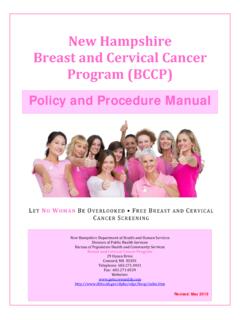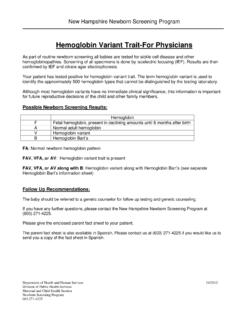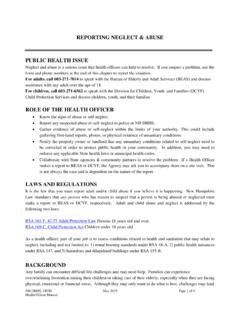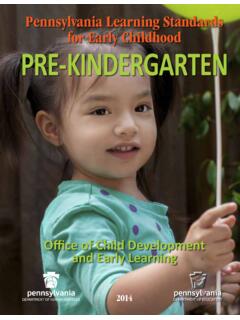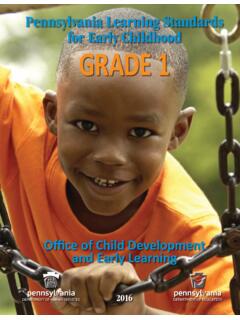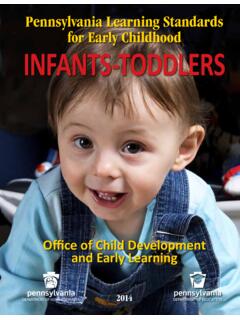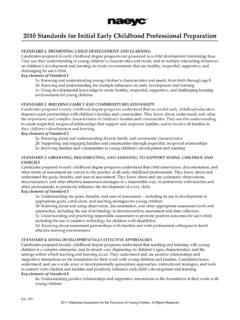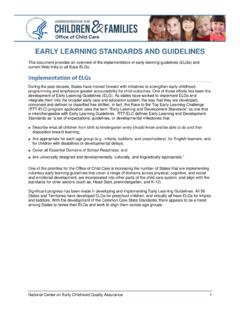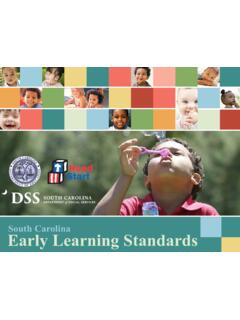Transcription of NH Early lEarNiNg StaNdardS
1 BirththroughFiveNH Early lEarNiNg StaNdardSPurposes of the NH Early lEarNiNg StaNdardS ..2 Guiding Principles ..2 Early lEarNiNg and Matters! ..3 How Children Learn ..4 Cultural Influences on Development and lEarNiNg ..7 Dual Language Learners ..8 How the StaNdardS Can Be a Resource for You ..10 Guide to the Early lEarNiNg StaNdardS ..11 Social and Emotional Development ..12 Language Development and Emergent Literacy ..17 Cognitive Development Early Numeracy ..25 Cognitive Development Science and Social Studies ..30 Cognitive Development Approaches to lEarNiNg ..33 Physical Development and Health ..40 Creative Expression and Aesthetic Appreciation ..45 Differences in Development ..48 Partnering with Families When You Have a Concern about a Child s Development ..50 Resources and References ..52 Acknowledgements ..54 Table of Contents 2 Purposes of the NH Early lEarNiNg StandardsThe New Hampshire Early lEarNiNg StaNdardS are a statewide resource for everyone who loves, cares for, and educates young children.
2 The StaNdardS provide essential information to support and enhance children s development and Hampshire s Early lEarNiNg StaNdardS : Provide a resource about children s development from birth through age five; Promote a whole-child approach that affirms that lEarNiNg and development are interrelated and build on previous lEarNiNg ; Acknowledge, honor, and embrace the tremendous diversity and variation that exists for children and families; Recognize and celebrate what children learn to help plan for the next stages of growth and development; Align with the NH Kindergarten Readiness Indicators, which are aligned with the NH College and Career Ready StaNdardS ; Provide a list of resources for more information about children s lEarNiNg and development; and Guide the choice of developmentally appropriate curriculum, teaching strategies, and Hampshire s Early lEarNiNg StaNdardS aspire to: Encourage dialogue and sharing between everyone who loves, cares for, and educates young children; Inform professional development for Early childhood professionals; Incorporate current and culturally inclusive research on child development; and Develop and nurture the relationship between Early lEarNiNg and K-12 so that all schools are ready for all children and all children are ready for important as it is to understand what the Early lEarNiNg StaNdardS are, it is equally important to understand what they are New Hampshire s Early lEarNiNg StaNdardS are NOT: Not an exhaustive guide to child development or a developmental checklist.
3 Children s development is highly individualized and unique to each child; Not an assessment tool or for use to determine children s eligibility for various programs or services; Not a curriculum; Not an instrument to collect statewide information on the overall status of children in the State of New Hampshire; and Not permanent and unchanging. New Hampshire is committed to updating the Early lEarNiNg StaNdardS PrinciplesWe believe that the NH Early lEarNiNg StaNdardS should: Respect and be inclusive of diverse families, cultures, languages, perspectives, and abilities; Build from what we know about young children s development and respect the holistic nature of Early lEarNiNg and the key role of play; Provide a tool for families, Early childhood professionals, and elementary school teachers to use in understanding developmentally appropriate expectations of children in order to successfully transition from Early childhood programs to elementary schools; Inform adults intentional practice with children and knowledge of child development.
4 Include domains that are meaningful to the respective developmental stages and be responsive to developmental expectations included in the 11 domains expected by the Federal Office of Child Care; Be user friendly, including accessible language that is clear and straightforward for families, teachers, and other Early childhood professionals; Align* with NH College and Career Ready StaNdardS , Head Start Child Development & Early lEarNiNg Framework, and preschool special education outcomes; Be responsive to the skills and knowledge young children need for success in a changing world; and Be informed by the current research.*For the purposes of these guiding principles, the word align will mean to bring into desirable relation, to harmonize the aims and practices of two systems. This means, therefore, that we are not seeking a one to one correspondence between an Early childhood developmental indicator and an elementary school standard, but, instead, are seeking to assure that Early childhood and elementary school teachers are attending to the same domains and subject lEarNiNg StaNdardS Task Force and Steering Committee, 2011NH Early lEarNiNg StaNdardS 3 Early lEarNiNg and Development.
5 It Matters!The Early years of a child s life are we know a great deal about how children grow and develop. Children are lEarNiNg at birth even before. The Early years are the most extraordinary period of growth and development in a child s lifetime. A child s very first year is crucial for building the brain. The figure at right highlights how a child s senses, language, and knowing (cognition) all burst into high gear from before birth and in the first 12 months of life. Interactions with parents, Early childhood professionals, and other caring adults play a key role in brain development. There are less than 2000 days from the time a child is born until he or she enters kinder-garten. Every day through kindergarten sets the infants and toddlers develop, they first become aware of and then start to make sense of their world. The years from birth through kindergarten lay the foundation for a child s future lEarNiNg and development.
6 This is the time to maximize each child s lEarNiNg potential. Birth through kindergarten is also the time for families and Early childhood professionals to observe and monitor each child s development closely. Every child grows and develops at his or her own pace. It is important for families to talk with Early childhood professionals about milestones the child has reached and what to expect next. It is also important for families to tell the child s health care provider if they have any concerns. Photo credit: Center on the Developing Child at Harvard University. Used by permission. Nelson, , in From Neurons to Neighborhoods: The Science of Early Childhood Development (2000). Shonkoff, J. & Phillips, D. (Eds.). 4 How Children LearnLearning starts with families and are their children s first, most important, and life-long teachers.
7 They are also responsible for their children 24 hours a day, seven days a week, no matter what, until the children grow up. Families care about their children and look for ways to support their healthy growth. This can be hard work! Families embed their children in a web of relatives, friends, and social networks. This community offers safety, opportunities, lEarNiNg , and support. Family and community traditions, languages, and activities are the foundation for children s lEarNiNg and development. Children build their identities from the people, communities, and places in their lives. Over time, the web of support expands to include Early childhood professionals, health care providers, librarians, and others who serve children and communication among families, caregivers, and teachers is essential for children s lEarNiNg . Children are in several different environments during the course of a day. To promote consistency for children, families can talk with caregivers and teachers Early on about the family s traditions, language, daily routines, and the family s and child s preferences for foods and activities.
8 Together, they can look for ways to provide continuity, such as having consistent meal times and familiar foods. Caregivers and teachers can make sure they say the child s and family s name correctly, learn a few key words and phrases in the child s home language, and find out what the child enjoys. They can also include in the care setting or classroom some materials, photographs, and/or art that reflect the interests of the child and family. Over time, families can pay attention to their child s connection with the various caregivers to ensure there are strong is important to remember that expectations for lEarNiNg and development are in part determined by social and cultural val-ues and goals. Your ideas about lEarNiNg and development are influenced by your culture and background and may differ from the ideas of the families with whom you work. Communication with families is essential for understanding and working to honor their values and goals.
9 Every child and family has unique gifts and child has a unique set of strengths, talents, and interests, along with areas where he or she needs more support. Children grow and learn at their own pace. It is not possible to tell exactly when a child will perfect a given skill. For some children, health care needs, disabilities, or developmental delays may affect how and when they learn and grow. It is important for adults to sup-port children where they are, developmentally, to extend their lEarNiNg and who have disabilities or developmental delays, or who are at risk for delays, may need special attention. Like all young children, they are developing the ability to communicate their thoughts and feelings and lEarNiNg about social cues. Early child-hood professionals support the social and emotional development of all children, including providing individual guidance as needed. For example, some children face challenges in developing suc-cessful relationships with other children or in sustaining play.
10 Screening and Early intervention are learn best when they are healthy, safe, and have good need to have their basic needs met in order to learn. Health care for pregnant women is a first step for healthy develop-ment. Well-child visits provide important reviews of development, behavior, immunizations, oral health, vision, and hearing. Every day, balanced nutrition, adequate sleep, and physical activity help children grow, and set the stage for lifelong healthy habits and lEarNiNg . Children also need safe places to live and play. They need to learn when and how to call on a trusted adult for learn through relationships, play, and active learn through the relationships they have with their parents, families, Early childhood professionals, and communi-ties. Children observe their families and caregivers closely and respond. When children reach out for connections with adults and adults reciprocate, this back-and-forth process of serve and return interactions helps build children s brains.





